| Designation: | LAV-300 |
 |
|---|---|---|
| Manufacturer: | Textron Marine & Land Systems | |
| Product type: | Armoured Vehicles | |
| Name: | Wheeled armoured personnel carrier |
Textron's rugged and reliable 6X6 class of vehicles includes the LAV 300 MK II and LAV 600 models. The fully amphibious LAV 300, offered in 15 mission-ready configurations, is capable of speeds up to 65 mph and can be air-transported by C-5A, C-141 and C-130 aircraft. The LAV 600 offers superior mobility, coupled with 105-mm firepower not generally found in a vehicle of its class, while remaining C-130 transportable.
The LAV-300 armoured vehicle range was developed by Cadillac Gage Textron (which in 1994 became part of Textron Marine & Land Systems) as a private venture specifically for the export market in the late 1970s.
The vehicle was originally known as the V-300 and builds on experience in the development and production of the LAV-150 range of 4 × 4 light armoured vehicles covered in detail in a separate entry. Production of this has been completed and currently in production is the M1117 Guardian Armoured Security Vehicle of which over 1,000 have been built.
The first two prototypes of the LAV-300 were completed in 1979 and the first customer was Panama which, in 1982, placed an order for 12 LAV-300 vehicles in four different configurations including fire support vehicle with a two-person turret armed with a 90 mm CMI Defence Mk III gun, APC with twin 7.62 mm machine guns and recovery. All of these were delivered by the end of 1983. In 1984, the Kuwait National Guard ordered 62 LAV-300 Commandos. These were lost during the Iraqi invasion of Kuwait in 1990.
Production of the LAV-300 resumed in 1993 as, late in March 1993, the US Army Tank Automotive Command awarded Cadillac Gage a contract for the supply of 24 LAV-300s (6 × 6) for the Philippines.
Of the 24 vehicles, 12 have a two-man Cadillac Gage turret armed with a 90 mm gun and a 7.62 mm machine gun, and the remaining 12 a Cadillac Gage one-person 1 m turret armed with one .50 (12.7 mm) M2 HB and one 7.62 mm machine gun.
Total value of the contract was USD18.243 million, with production undertaken at the Textron Marine & Land Systems facility at New Orleans, Louisiana. First deliveries were made in September 1994.
There has been no recent production of the LAV-300 series of 6 × 6 armoured vehicles, although marketing continues.
The latest model of the LAV-300 series is designated the Mk II and details of this are given at the end of this entry. This is the current model being offered on the world market. Description
The hull of the LAV-300 is of all-welded unitised construction of special high-hardness steel ballistic plate that protects the crew from small arms fire and shell splinters. If required, a higher level of passive armour protection is available for the LAV-300 series.
According to the company, the special high-hardness steel ballistic plate will defeat multiple hits of 7.62 mm ball ammunition all round and 7.62 mm armour piercing through a frontal arc of 60°.
The driver sits at the front of the hull on the left side and has a single-piece square hatch cover that opens to the rear. To his front are three day periscopes for forward observation and one of these can be replaced by a passive periscope for driving at night. In the side of the hull to the left of the driver is a bulletproof vision block with a firing port underneath. To the rear of the driver is seated another member of the crew who is provided with a single-piece hatch cover, although he can also enter his position via the rear troop compartment. To his left is a small half door that opens to the rear, which is provided with a vision block and a firing port.
The engine compartment is to the right of the driver with the air inlet and outlet in the roof and the exhaust pipe in the right side of the hull. Power from the Cummins 6 TCA 8.30-C260 diesel engine is transmitted to the final drives via an Allison Transmission MT-643 six-speed automatic gearbox. The transfer box contains a two-speed system with a spline engagement clutch for the axle drive.
On the glacis plate is a holder for a shovel and pick axe and under the nose is an internally mounted hydraulic winch which has a maximum capacity of 9,000 kg. This is provided with 46 m of 12.7 mm diameter steel core cable.
The LAV-300 can be fitted with a number of armament installations mounted in the centre of the hull over the second axle and these include:
- Cadillac Gage two-man power-operated turret with a 90 mm CMI Defence Mk III gun (described in the LAV-150 entry)
- One-man turret armed with 40 mm MK 19 grenade launcher and 12.7 mm machine gun (described in the LAV-150 entry)
- Two-man power-operated turret armed with 30 mm cannon, 7.62 mm coaxial machine gun and 7.62 mm anti-aircraft machine gun (described in the LAV-150 entry)
- Turret armed with a 25 mm M242 the ATK Gun Systems Company M242 Chain Gun, 7.62 mm coaxial and 7.62 mm anti-aircraft machine guns and smoke grenade dischargers.
- Cadillac Gage two-man power-operated turret with a 20 mm Oerlikon Contraves cannon (described in the LAV-150 entry)
- Cadillac Gage one-man 1 m machine gun turret (described in the LAV-150 entry)
- Cadillac Gage one-man machine gun turret (described in the LAV-150 entry)
- Ring mount with a 7.62 mm or 12.7 mm M2 HB machine gun
The troop compartment is at the rear of the LAV-300 and in each side of the hull are three bulletproof vision blocks each with a firing port underneath. Over the top of the troop compartment are two rectangular roof hatches hinged on the outside. The infantry enters and leaves the vehicle through two doors in the rear of the hull, each of which has a bulletproof vision block with a firing port beneath. More recent production vehicles have a power-operated ramp in the rear, which is provided with a single door in the left side with a vision block/firing port. There is another vision block/firing port to the right. As an alternative to the two-part hatch cover, a circular hatch cover with provision for mounting a 7.62 mm pintle-mounted GPMG can be fitted.
The front suspension is a swing-mounted solid axle, with rear suspension independent with coil springs at each wheel station. The solid front axle is restrained longitudinally by trailing arms and laterally by stabilising rods attached to the axle and hull. The two rear axles consist of short drive shafts extending from the hull-mounted differentials to the independently sprung trailing arm-mounted wheel stations. The road wheels have a combined travel of 30 cm, a jounce of 17.5 cm and a rebound of 12.5 cm. All the swing-mounted axles are of the double-reduction top-mounted type. The front and rear axles have positive no-spin differentials to maintain traction in off-road operations. The central axles contain the inter-axle differential. All wheels have hydraulic brakes and steering is power-assisted on the front wheels. All wheels have run-flat tubeless tyres with a self-cleaning tread design.
The LAV-300 is fully amphibious without preparation, being propelled in the water by its wheels at a speed of 3 km/h. As an option, the vehicle can be fitted with water-jets which increase the water speed to 8 km/h. The amphibious version has a number of modifications to the hull including the installation of a trim vane on the front of the hull which is erected when the vehicle is afloat.
The LAV-300 can be carried slung under helicopters and a Lockheed Martin C-130 Hercules transport aircraft can carry one internally.
Standard equipment includes a 19 litre water can, 19 litre diesel fuel can, fire suppression system, pioneer tool kit, tow cable, slave cable, first aid kit, vehicle tool kit and engine-driven air compressor with hose. All vehicles are fitted with a front-mounted winch with a capacity of 9,000 kg with 46 m of cable and a snatch block.
The basic LAV-300 has a payload of 2,720 kg but with an uprated suspension this can be increased to 4,080 kg.
A wide range of optional equipment can be fitted to the LAV-300 series including various types of passive night vision devices, central tyre-inflation system that allows the driver to adjust the tyre pressure regulation system to suit the type of terrain being crossed, air conditioning system, heater, wiper kit, various smoke/grenade launchers, NBC system, automatic fire suppression system, to name but a few.
The latest LAV-300 Mk II (6 × 6) APC and variants have been marketed in Turkey by the local company of HEMA Endustria AS with the vehicle being called Hitit. As of November 2007 no sales had been made to Turkey. Variants
Fitted with an external top-mounted swing-up launcher with an elevation of +30°, depression of -10° and traverse of 360°. There are nine Raytheon Systems Company TOW ATGW missiles (maximum range 3,750 m) carried plus a 7.62 mm machine gun and 2,000 rounds of ammunition. This version has yet to enter production or service.
Fitted with a turntable-mounted 81 mm mortar with elevation from +43 to +85°, total traverse of 360°, range of 150 to 4,400 m and a total of 62 mortar bombs carried. Also fitted with a 7.62 mm machine gun for which 2,000 rounds of ammunition are carried. The 81 mm mortar can also be dismounted for ground use.
This proposed version would be fitted with the French TDA 120 mm 120R 2M mortar system which is fully covered in a separate entry. A baseplate would also be carried to allow the 120 mm mortar to be used in the dismounted ground role.
This version would have a raised roof at the rear for use in the command post role and would typically have a total crew of 10 and a combat weight of 13,154 kg.
This version would have a raised roof at the rear and be fitted with a hydraulically operated crane capable of lifting a load of 3 tonnes at a distance of 3 m. A wide range of optional equipment can be fitted such as generator, work bench, searchlight, cutting and welding equipment.
This version would have a raised roof and be fitted with an A-frame which when erected can lift a maximum load of 4.536 tonnes with stabilisers deployed. It would also have a winch with a maximum payload of 11.34 tonnes.
This model would be unarmed and fitted with a raised roof and ramp in place of twin doors at the rear to facilitate the loading of stretchers and walking wounded.
These include cargo carrier, and anti-aircraft with a missile system such as ADATS, or a gun system such as the 20 mm Vulcan as installed on a number of LAV-150 4 × 4 vehicles supplied many years ago to the Saudi Arabian National Guard (SANG).
Late in 1999, Textron Marine and Land Systems started marketing an enhanced version of the LAV-300 (6 × 6) series of light armoured vehicles called the Mk II.
In the Mk II design, the overall layout of the Mk I has been retained with the driver front left, power pack to the right and crew/weapon compartment at the rear.
According to Textron Marine & Land Systems, the overall general shape of the LAV-300 has been retained by choice to retain ballistic protection obliquity angles, keep a low silhouette/profile for passive defence and ease of air transportability.
The all-welded steel armour hull has been retained, but the steel ballistic plate chemistry and hardness levels have been improved to provide a better protection level. The baseline hull provides protection from 7.62 mm ball attack through 360° and against 7.62 mm armour-piercing over the frontal 60° arc. A higher level of protection is available if required with the addition of a German IBD developed passive armour package.
New brush guards have been added to the hull front as have new larger rear-view mirrors for improved vision. Additional interior/exterior equipment racks have been added to allow for increased stowage.
For improved safety and comfort, an improved fully adjustable driver's seat has been fitted, as has a new design of instrument panel. The driver also has a new adjustable steering wheel that can be quickly altered to suit the stature of the driver.
A new power pack has already been installed which is similar to that recently installed in the Swiss MOWAG Piranha Generation III vehicles. A new engine air intake grill/door has been added to improve air flow and delete any special pre-preparation prior to swimming operations.
The power pack consists of a Cummins QSC 8.3 turbocharged and after-cooled diesel engine developing 208 kW at 2,000 rpm and with a peak torque of 1,183 Nm at 1,400 rpm.
This engine meets the latest environmental emission standards and is fitted with electronic controls to provide an engine management system and automotive diagnostics for maintenance and repair.
The engine is coupled to an Allison MD3560 six-speed automatic transmission with electronic control and self-diagnostics and a new single-speed transfer case. The driver has push-button controls for full 6 × 6 or 6 × 4 drive and an engine-driven exhaust retarder has been fitted to provide additional braking capacity.
The transfer case also has a neutral position so allowing the vehicle to be towed without any preparation. In some other vehicle designs the drive shaft has to be disconnected to allow the vehicle to be towed without damaging the transmission.
The vehicle has a maximum road speed of 105 km/h and is propelled in the water by its wheels at a maximum speed of 3 km/h.
The single diesel fuel tank of the Mk I has been replaced by twin diesel fuel tanks which has increased fuel capacity to 435 litres so increasing the operational range of the LAV-300 vehicle to 925 km.
The front of the hull has been redesigned and widened, with the winch compartment moved from the lower glacis to the front top glacis. The winch has a capacity of 9,000 kg and is provided with 46 m of cable leading out through the front of the hull.
Early vehicles had twin doors in the hull rear but the Mk II has a redesigned hull rear fitted with a power-operated ramp with an integral door. This enables easier entry and exit by the troops as well as enabling the vehicle to be more easily used in specialised roles, such as ambulance and cargo.
Space for integral water jets has also been designed into the hull, this being an optional extra and gives the LAV-300 Mk II a maximum water speed of 8 km/h. Before entering the water, the bilge pumps are switched on and the trim vane is hydraulically erected at the front of the vehicle.
The top of the hull of the Mk II has been redesigned and a commander's hatch and two top-rear troop hatches added. Larger driver and commander periscopes/vision blocks have also been installed.
On the Mk I the troops were provided with individual seats, but the Mk II has bench-type seats either side, which are said to allow quicker entry and exit from the vehicle. For improved comfort a new high-capacity air conditioning/heater system has been installed and a new ration heater.
For increased load carrying capacity the LAV-300 Mk II has been fitted with new springs and shock-absorbers and maximum vehicle weight (vehicle plus payload) is 16,330 kg.
The original bias ply hard sidewall run-flat tyres have been replaced by radial ply tyres that have run-flat inserts. According to Textron Marine & Land Systems these offer the user improved mobility, ride and lower costs.
The new tyres have been fitted onto new wheels to improve tyre fitting and removal. A new driver operated central tyre inflation system has been fitted which allows the driver to automatically adjust the tyre pressure to suit the type of terrain being traversed at any time. Steering is power-assisted on front wheels.
In the future it is expected that the present trailing arm independent suspension and wishbone type of the LAV-300 Mk II, could be replaced with the new fully independent front and rear suspension from the Textron Marine & Land Systems M1117 Armored Security Vehicle (ASV), which is in production for the US Army Military Police. This will allow the gross weight of the LAV-300 to increase to over 21,000 kg. As far as it is known this has not reached the prototype stage.
This 6 × 6 vehicle fitted with a three-person turret armed with a 105 mm gun was developed in the mid-1980s. It never entered production and is no longer being marketed.
|
||||||||||||||||||||||||||||||||||||||||||||||||||||||||
|
|||||||||||||||
|
||||||||||||||||||
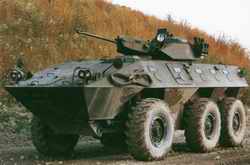 |
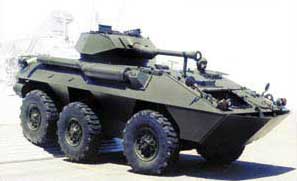 |
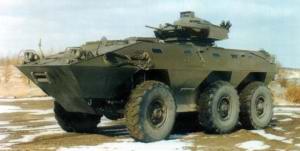 |
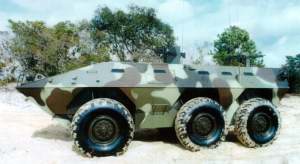 |
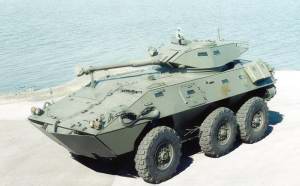 |
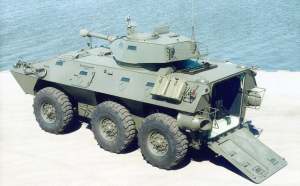 |



